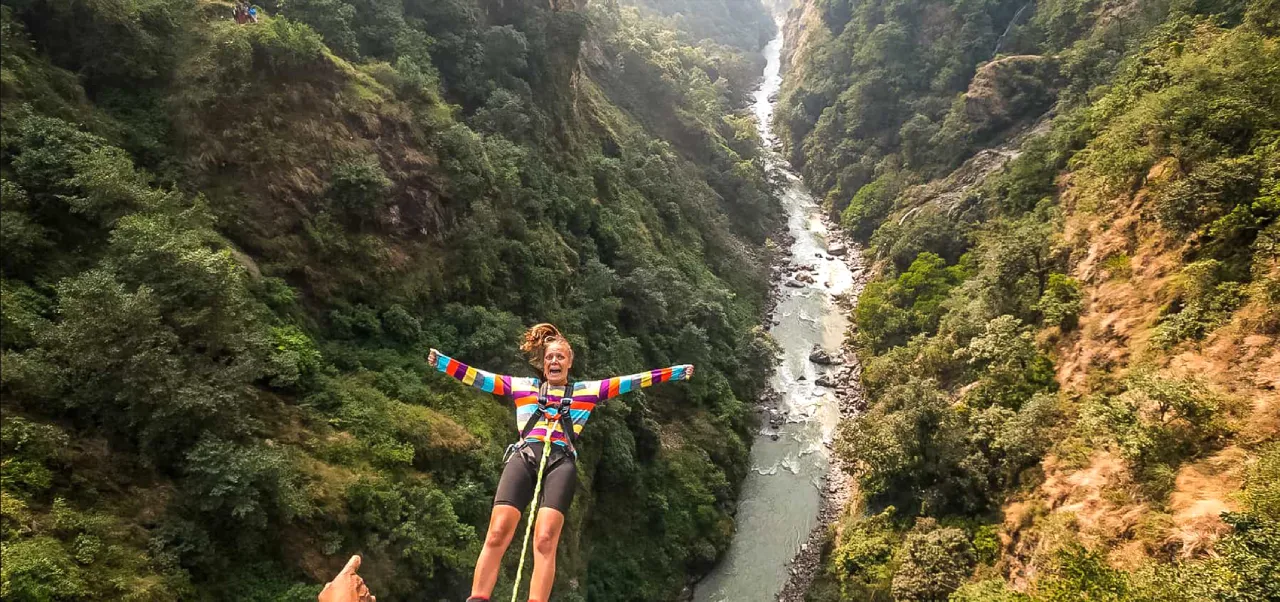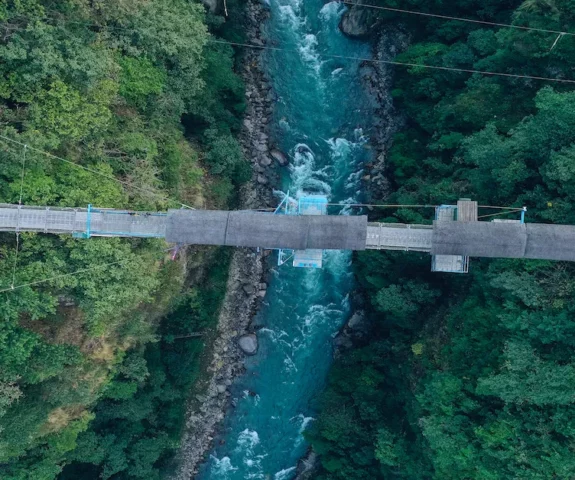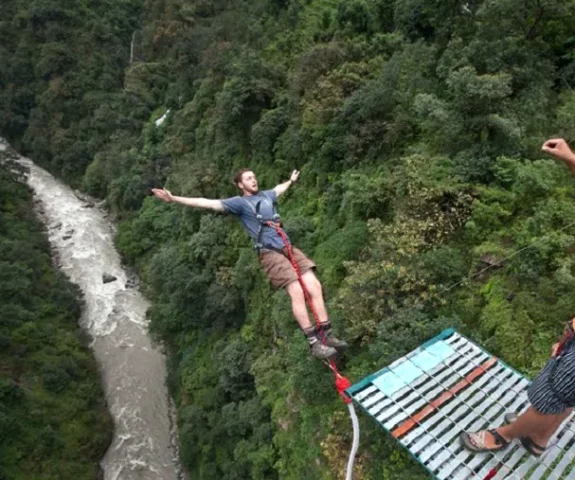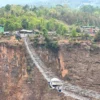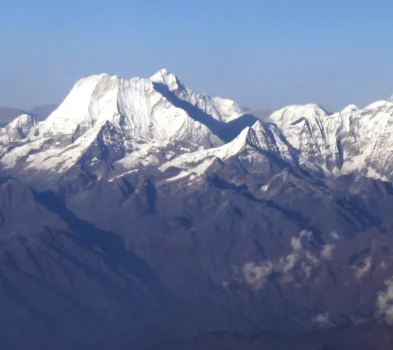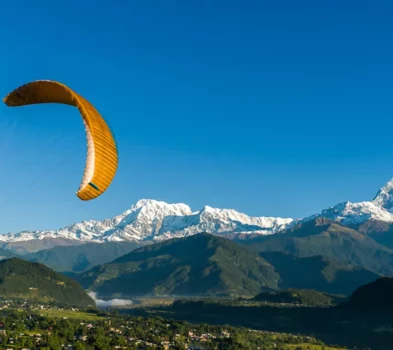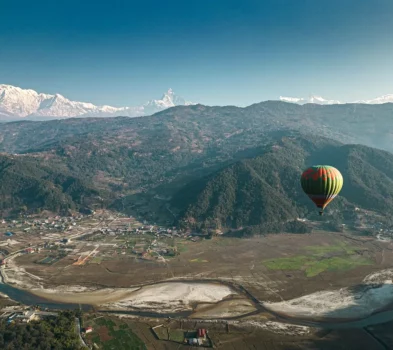Duration
9-10 hoursBungee jump in Nepal
Trip Grade
EasyGroup Size
1-16 PeopleMax Altitude
1,215m. / 3,986ft.Best Season
Feb- May/ Sept- NovActivity
Adventure SportsMeals
LunchTransportation
Sharing BusTrip Customization
On request (click here)Highlights of Bungee jump in Nepal
- Highest natural bungee jump in the world.
- The deepest gorge of Bhotekoshi River.
- Near to the Tibet border.
- Adventure experience in Bhotekoshi.
- High cliff and landscape.
Trip Introduction
Near Tibet Border (Tatopani), the ultimate Bungee Jump at the Bhotekoshi River in Nepal. This may be the most spectacular Bungee Jump in Nepal or on the Planet. This remarkable 515 ft (165m) drop into the Bhote Koshi River gorge in Nepal on the Tibet border side is the longest and deepest natural Free-fall in the world.
Bungee Jump at the last resort in Nepal is the ultimate Rush adventure trip. Bungee Jump in Nepal spot is located at a 4-5 hours drive and 105 km northeast of Kathmandu valley. Close within 12 km of the Tibet border, Bhoti Koshi River’s ultimate Bungee jump in Nepal takes on the 166m wide steel suspension bridge and at an altitude of 3600 feet.
This Suspension Bridge is specially designed for adventure purposes, with Bungee jumping from Swiss management. This is a huge construction on the Bhote Koshi, over 6000 meters of steel wire was used to build the suspension bridge. The bridge joins the two sides of the Bhotekoshi River. This means that the bridge will hold 41,500kg of metal. This suspension bridge helps the local community pass from one village to another. Their economy is also supported due to tourist activities. They used to walk for many hours to cross this river.
Your safety is our primary concern. Thus, we deploy our best crew to guide you through the Jumping. With years of experience under our belt, we know what our clients need to make their trip an enjoyable and memorable one. And, we, Himalayan Adventure Treks, welcome all of you to experience this adventure of a lifetime.
Outline Itinerary of Bungee jump in Nepal
Day o1: Bungee Jumping Adventure at The Last Resort – A Thrilling Experience.
Our guests sharing their experiences (Photo/Video Gallery)
Detail itinerary of Bungee jump in Nepal
Day o1: Bungee Jumping Adventure at The Last Resort – A Thrilling Experience.
05:00 AM – Early Morning Departure from Thamel, Kathmandu
Your day starts early at 5:00 AM, as you depart from Thamel for an adrenaline-filled adventure at The Last Resort, home to one of Nepal’s most thrilling bungee jumping spots. The journey takes approximately 4 to 5 hours, covering about 100 km towards the Nepal-Tibet border. Along the way, you will enjoy scenic views of lush green hills, winding rivers, and local villages.
10:00 AM – Arrival & Breakfast at The Last Resort
Upon arrival, you will be welcomed at The Last Resort, an adventure hub nestled in the breathtaking Bhotekoshi River Gorge. Before the jump, enjoy a delicious breakfast while taking in the spectacular views of the deep canyon, rushing river, and surrounding forests.
10:30 AM – Bungee Jumping Over the Suspension Bridge
After a safety briefing and instructions from expert guides, it’s time for the ultimate adrenaline rush – the Bungee Jump! Standing on the 166-meter-high suspension bridge, you will experience a heart-pounding free fall towards the roaring Bhotekoshi River. This is one of the highest bungee jumps in Asia, making it a must-try for adventure enthusiasts.
Optional Adventures (Can be Added)
If you want to make your adventure day even more thrilling, you can add:
- The Canyon Swing – A massive swing experience, where you free-fall before swinging back and forth in the canyon.
- White Water Rafting in the Bhotekoshi River – Experience intense rapids on one of Nepal’s most extreme rivers.
- Local Exploration – Walk around The Last Resort area, interact with locals, and take in the stunning Himalayan landscapes.
02:00 PM – Drive Back to Kathmandu
After a thrilling adventure, you will depart back to Kathmandu. The return journey takes another 4-5 hours, allowing you to relax and enjoy the scenic drive.
07:00 PM – Arrival in Kathmandu
By evening, you will reach Thamel, Kathmandu, where you can share your experiences, check out the adventure photos/videos, or relax after an action-packed day.
Additional Notes:
- A private vehicle upgrade is available for an extra cost for a more comfortable journey.
- Advance booking is recommended, especially during peak seasons.
- Wear comfortable clothes and sports shoes for the jump.
This bungee jumping experience at The Last Resort is an unforgettable adventure, offering an adrenaline rush, breathtaking views, and memories that last a lifetime! 🚀
Activity: Drive, Adventure Activity, 12-13 hours
Max. Altitude: 1,215m/3,986ft. Tibet Border
Meal: Lunch
Note:
If you have your own private group and want to make your trip private, we can run the custom trip all the day as per your requirements and group size.
Includes and Excludes
What are included with package?
- Transportation by bus from Kathmandu to Last Resort and return: Includes round-trip transportation in a comfortable tourist bus with scenic views along the way.
- Lunch in Last Resort: Buffet-style lunch with a variety of local and continental dishes in a beautiful riverside setting.
- Bungee jump Ticket: Includes one bungee jump per person from a 160-meter high suspension bridge over the Bhotekoshi River.
What are not included with package?
- Beverage drink: Any kind of soft drinks, alcoholic beverages, or bottled drinks are not included.
- Extra food: Additional meals or snacks beyond the provided lunch are not covered.
- Private transportation: Use of a private vehicle instead of the group bus service comes at an extra cost.
Pick Your Suitable Date
Book a Private Trip
Private & Group Discount Price
-
1 -
1 person
US$ 200
-
2 -
2 people
US$ 175
-
3 -
5 people
US$ 160
-
6 -
10 people
US$ 150
-
11 + people
9999
US$ 140
Total Cost:
US$ 200
Trip Information
About Country
Popularly recognized worldwide for its majestic sky-dominating peaks, Nepal is one of the most sought-after nations for trekking and other adventure activities. This tiny Himalayan nation is home to eight of the world’s tallest peaks, including Mt. Everest (8848.86m)- the highest mountain in the world.
Moreover, the rugged and rural trekking trails to the massifs along the dense forest which is filled with exotic floras and faunas instills excitement and adventures to the travelers. However, traveling to Nepal is not only about the mountains and natural beauty. Unraveling the beauty that lies in the old monuments, palaces, and temples. Nepal has a diverse array of cultures, traditions, languages, and history which are reflected in the lifestyle of the people.
Key Facts
Location: Nepal is located in South Asia; between two great giants the Republic of China to the north and India to the south, east, and west.
Geography: A landlocked country, Nepal is divided into three geographical regions, namely, the Himalayas, the Hills, and the Terai.
Capital: The capital city of Nepal is Kathmandu.
Area: The total area of Nepal is 147,181sq km.
Population: The current population of Nepal is 29 million.
Political system: Nepal is a federal republic country with a multi-party system.
Major religion: Nepal is a secular state but the majority of people follow Hinduism, followed by Buddhism and Christianity.
Time zone: The time zone of Nepal is GMT +5:45.
Official Language: The official language of Nepal is Nepali.
Working hours: The working hours in Nepal are from 10 am to 5 pm.
Electricity: Currently, all the major cities have electricity while electricity supply in some rural areas is limited. The standard voltage of electricity in Nepal is 220V.
Visa Information
All tourists visiting Nepal except tourists from India should have a valid passport and visa. An On-Arrival visa to enter can be obtained at the Tribhuvan International Airport or any other land entry/exit points at the Nepal-Tibet and Nepal-India border. During the peak season, there will be a long line of tourists here trying to get their visa. So, to avoid the endless waiting you should visit the nearest Nepalese diplomatic missions stationed in your country before your arrival.
An On-Arrival Tourist Visa costs USD 30 for 15 days, USD 50 for 30 days, and USD 125 for 90 days. Find more information regarding the updated visa fees at http://www.nepalimmigration.gov.np/post/notice-regarding-visa-fee-updates.
You can also extend your visa within a valid period which will cost you USD 3 per day. However, if you are visiting Nepal from SAARC countries you don’t have to pay visa fees as gratis fee or free visa is applicable for 100 days. Regarding information about tourist visas, you can head to the information on the official website of the Department of Immigration at http://www.nepalimmigration.gov.np/page/tourist-visa.
How to reach the country
Nepal is very well accessible via air, rail, and road. Tribhuvan International Airport is the only international airport and the entry point for those arriving by air. Nepal Airlines is the main operator in the nation. Other international airlines here are Air Arabia, Air Asia, Etihad airlines, Fly Dubai, Jet Airways, Malaysia Airlines, Qatar Airways, Silk Air, and Thai air. The rail and road service can only be used by those arriving from India.
In terms of land transport, there are several land entry/exit points at the Nepal-Tibet and Nepal-India borders. Kerung and Kodari are the entry/exit points at the Nepal-Tibet border whereas
Janakpur-Jainagar railway is the sole railway that connects Nepal with India, several buses connect Delhi and Kathmandu.
Popular destinations to visit
There are many places you can visit in Nepal. Nepal is not only gifted with natural beauty but it is also culturally rich which means there are many heritages and sites you can visit. Kathmandu Valley is the first and foremost destination that you should not miss out on. The seven UNESCO world heritage sites in the valley, namely, Patan Durbar Square, Bhaktapur Durbar Square, Kathmandu Durbar Square, Pashupatinath, Swayambhunath, Boudhanath, and Changunarayan.
Other places you must visit while in Nepal are Pokhara, Chitwan, and Lumbini. Pokhara is a scenic lake city, located 6 hours’ drive away from Kathmandu city. There you will be able to enjoy the serene and peaceful nature with the Annapurna ranges in the backdrop. Lumbini, the birthplace of Lord Buddha, is a historic destination whereas the Chitwan National Park is a natural haven for exotic flora and fauna. Both of these are also enlisted as world heritage sites by UNESCO. Palpa, Bandipur, Bardiya National Park, and Ilam are some of the popular destinations.
As for trekking and mountaineering activities, Annapurna, Everest, Langtang, Manaslu, Upper Mustang, and Dolpo regions are some of the most popular ones in Nepal.
Internet and Communication in the country
You do not have to worry about not getting communication service or Internet service in Nepal. In recent years, the internet and communication services have drastically progressed and developed. While in the major cities and tourist destinations, you can use free Wi-Fi including many of the cafes and restaurants. Similarly, almost every hotel and some public areas provide Wi-Fi services. However, Wi-Fi is not always available in remote areas in the Himalayas and rural Hilly regions.
In such situations, a cellular connection is the best option for both Internet access and communication. NTC and Ncell at two of the biggest telecommunication corporations and offer sim cards with various packages at a reasonable price. These service providers have a wide reach over many parts of Nepal. You will easily be able to purchase any sim card with your passport or identity card.
Local currency and foreign exchange
While in Nepal, you should use Nepali rupees (NRs) which is also the official currency of Nepal. You can easily exchange your currency into Nepalese Rupee at the Tribhuvan International Airport or the exchange counters and banks around the major cities. Also, the major cities like Kathmandu, Pokhara, Chitwan, and Lumbini have a great availability of banks and ATMs. However, their availability becomes quite scarce when you head to the Himalayas and remote areas.
So, it is best if the travelers perform all their money-related activities while they are in the major cities.
Weather and climate
The climate in Nepal varies according to altitude and the current season. The lowland of the Terai region in the southern part of the country is very hot and humid during the summer. The temperature there can get as high as 45 degrees Celsius. The middle part is also known as the hilly region has a pleasant and bearable climate all year long. However, in winter the nights and early mornings can get quite chilly. The Himalayan region is the northernmost part of the country and is above 3300m. This region usually has alpine climatic conditions and during the winter season, it experiences adverse weather conditions.
Nepal generally has four seasons, namely, spring, summer, autumn, and winter. The spring here means every part of the country has flowers blooming and summer means a lot of humidity and rainfall. While the autumn is neither too hot nor too cold and the skies are always clear. The winter season brings snow in the Himalayan region and some parts of the hilly region as well. Finally, during the monsoon season, the entire country experiences heavy rainfall except in the rain shadow areas of Upper Dolpo and Mustang.
People, culture, and festivals
Nepalese are known to be one of the kindest people all over the world. With a smile on everyone’s face, you will be warmly welcomed and greeted. The word “Namaste” is used while they join their hands together which means a respectful greeting. Nepal is a culturally rich country with many different castes, languages, and traditions. The diverse culture and tradition result in many different festivals celebrated all around the nation.
The major festivals celebrated are Dashain, Tihar, Holi, Sonam Losar, Gyalpo Losar, and many more. Especially in Newari settlements, people celebrate many colorful and radiant festivals. You will be able to experience wonderful and lifelong memory if you visit Nepal during the time of festivals.
Frequently Asked Questions
Where is the Bungee Jumping site in Nepal located?
The Bungee Jumping site is located near Tatopani, close to the Tibet border, approximately 105 kilometers northeast of Kathmandu. It is situated above the Bhote Koshi River, near The Last Resort, and is about a 4–5 hour drive from Kathmandu.
How high is the Bungee Jump at Bhote Koshi?
The jump is from a height of 515 feet (165 meters), making it one of the highest natural free-fall bungee jumps in the world. The leap is made from a 166-meter-wide steel suspension bridge over the Bhote Koshi River gorge.
What makes this Bungee Jump special or unique?
This Bungee is considered the most spectacular in Nepal and possibly the planet due to its natural setting, extreme height, and scenic gorge. The jump offers the longest natural free-fall into a river gorge surrounded by stunning Himalayan landscapes.
Who designed the Bungee Jumping bridge?
The suspension bridge used for bungee jumping was specially designed by Swiss engineers, focusing on maximum safety and durability. Over 6,000 meters of steel wire were used, and it can hold up to 41,500 kg of weight.
Is it safe to do the Bungee Jump at Bhote Koshi?
Yes, the jump is professionally operated and internationally certified with top-notch safety gear and procedures. It is managed under Swiss-trained professionals, ensuring a safe and thrilling experience for all jumpers.
What is the minimum age or weight limit for bungee jumping here?
Generally, the minimum age requirement is 18 years (or 16 with parental consent), and minimum weight is 40 kg, while maximum is around 100 kg. It’s essential to consult with the operator for exact requirements before booking.
Can beginners try the Bhote Koshi Bungee Jump?
Yes, this bungee jump is suitable for both first-time jumpers and experienced thrill-seekers. No prior experience is necessary, as trained professionals provide a full briefing and safety orientation before the jump.
How does this activity benefit the local community?
The bungee jumping bridge connects villages across the Bhote Koshi River, improving local mobility. Tourism also supports the local economy by providing employment and boosting businesses related to lodging, food, and guiding services.
What is the best time of year for bungee jumping in Bhote Koshi?
The best time to go is during spring (March–May) and autumn (September–November) when the weather is clear and pleasant. However, it operates year-round, except during heavy rain or unsafe weather conditions.
How do I book the Bhote Koshi Bungee Jump?
You can book this adventure through licensed travel and adventure tour operators in Nepal like Himalayan Adventure Treks. They offer transportation, meals, and guided services as part of the package.

